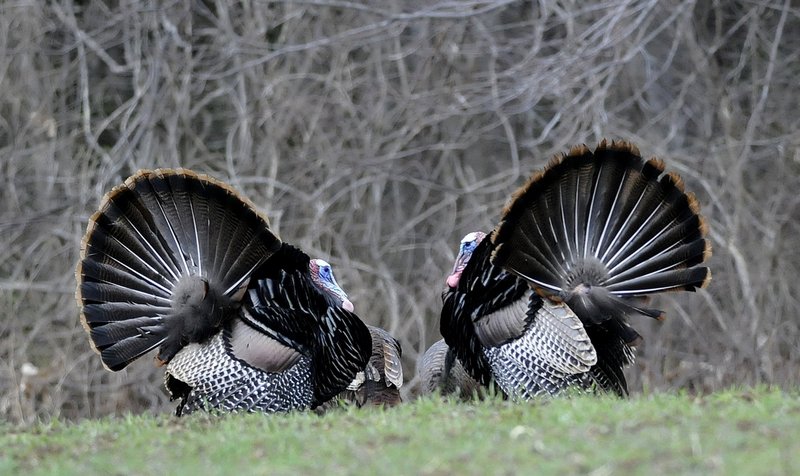You probably saw it in the news recently. Maine’s moose population is estimated at 76,000 moose. No matter how you count it, that’s a lot of moose.
The aerial moose census got me thinking Wouldn’t it be nice to have a wildlife census with the latest population estimates of all your favorite game species?
Since that wasn’t readily available, I asked Maine’s wildlife biologists to give their opinion on population estimates for some of Maine’s most popular game animals.
Jennifer Vashon is Inland Fisheries and Widlife’s black bear biologist, and has studied bears for 10 years. Maine is well-known nationally for its bear study, and the state’s radio telemetry bear tracking study is in its 35th year.
The Maine black bear population model is a result of monitoring the annual bear kill and tracking radio-collared females to see how many cubs they have with each litter. Last year’s bear kill was the lowest in 15 years, which was attributed to an extremely high abundance of natural food, keeping bears away from bait sites and hunters’ sights.
“The bear population numbers around 31,000 and has been increasing for the past five years,” said Vashon, who notes the population number is an approximate but is likely to be within 20 percent of that figure.
Reasons for the increase include fewer bear hunters and a resulting lower annual kill. Vashon said intensive forest management and the resulting regenerating forest has created a very productive forest that has lead to healthier bears including higher weights, faster growing bears and larger litters of cubs.
Game birds are difficult to census because there are so many of them and many only live two or three years.
While the U.S. Fish and Wildlife Service may have the physical and capital resources to count every duck on the breeding grounds, the state fish and wildlife agency does not, and relies on trends recorded from different sampling techniques.
Different types of surveys are used for different game birds.
With woodcock, biologists conduct a singing survey in the spring, where they listen for a woodcock’s song.
For grouse, a drumming survey is used during the spring mating season.
Since their reintroduction more than 30 years ago, wild turkeys have thrived in Maine. Biologists monitor the turkey population by using brood counts to identify trends.
During August, biologists and volunteers record how many turkey poults they see in a flock. That data is compared to past years to recognize population trends.
Brad Allen has been an IFW biologist for 32 years and the state’s head bird biologist since 1999.
Allen sees the turkey population as relatively stable. Over the past three years, the number of hunters and the kill number have been roughly the same, indicating a stable population.
“We can generate a turkey population estimate from the harvest,” said Allen. “Generally the turkey population is about 10 times the number of harvested male turkeys.”
Using that formula, Allen estimates that the wild turkey population in Maine is in the 60,000 range.
And that brings us to deer. More people hunt deer than any other species in Maine, and just where this population is headed is of serious concern to many throughout the state.
After severe winters in 2008 and ’09, Maine’s deer herd was blessed with a relatively short winter in 2010, and then two mild winters in 2011 and ’12.
According to Lee Kantar, the state’s deer biologist, those milder winters, coupled with a conservative allocation of any-deer permits the past three years, has the state deer population rebounding. Deer population estimates are generated through a combination of aerial flights, hunter surveys, deer kill data and winter severity.
Last year’s deer kill was 2,500 more than predicted. Hunting pressure and the number of hunters were at the predicted level, yet the kill was higher, indicating a higher population.
But while the deer population is rebounding in areas of the state where winter cover is essential for survival, deer populations are still at very low densities and susceptible to severe winters.
So where does that leave us concerning a statewide deer count?
“(It’s) 150,000-200,000, but things are definitely towards the higher end (and) talk of a ‘declining’ deer herd is old news. We are trending up,” said Kantar.
Mark Latti is a Registered Maine Guide, and the Landowner Relations/ Recreational Access Coordinator for the Department of Inland Fisheries and Wildlife.
Copy the Story Link
Send questions/comments to the editors.



Success. Please wait for the page to reload. If the page does not reload within 5 seconds, please refresh the page.
Enter your email and password to access comments.
Hi, to comment on stories you must . This profile is in addition to your subscription and website login.
Already have a commenting profile? .
Invalid username/password.
Please check your email to confirm and complete your registration.
Only subscribers are eligible to post comments. Please subscribe or login first for digital access. Here’s why.
Use the form below to reset your password. When you've submitted your account email, we will send an email with a reset code.